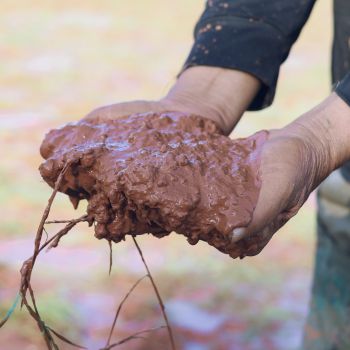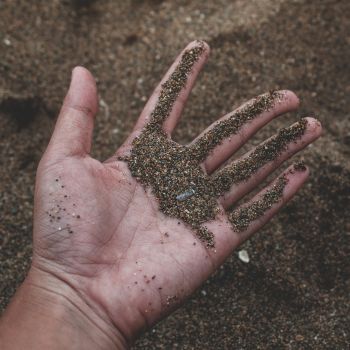Your soil is one of the keys to healthy plants and good growth, if it is not correct for the type of plant you just won’t get the results you are looking for. Soil is a living thing and needs to be looked after, containing not only particles of dirt and minerals, but insects, fungi, and bacteria, many of which are very beneficial to plants, and which in the best soils combine to create a balanced mixture of life that feeds and protects your plants.

Identifying your soil type
To find out what type of soil you have you need to do two tests. The first is to place a cup of your soil (from a finger depth from the top) into a jar and add water till 3/4 full. Stir well then wait a couple of hours for the soil to settle. When it has settled you will see layers of soil on the bottom.
The bottom layer will be sand, the next is silt, the next layer is clay, and if there is a layer on top of that it will be organic matter. The amount of each layer determines what your soil type is.
- If the clay layer is the thickest you have heavy soil that has a lot of clay content. These soils are hard to dig, sticky and hold too much moisture in wet weather. On the good side, they also hold a lot of nutrients. If you take a handful of the moist soil and squeeze it, it will hold together in a ball.
- If the silt and organic layers are the biggest you will have loamy soil. If you take a handful of your moist soil and squeeze it, it will hold into a ball but still be easy to break up and crumble. This is the best sort of soil.
- If the sand (bottom) layer is the largest, your soil is sandy. If you take a handful of moist, sandy soil and squeeze it, it will not hold its shape at all.
Of course there are soils that are a mixture of types but you can judge the basic type using this test.

The second test is the PH test. You can buy a simple PH testing kit from any garden center. Just follow the directions to see what the PH of your soil is. An acidic soil (low PH) can be used to grow blueberries, cranberries and azaleas. Alkaline (high PH) loving plants are many vegetables and seaside plants like lavender, maples and carnations.
Good soil is friable (crumbly) and well drained with the correct PH and nutrient ratios. It will have a good ratio of all the soil types above.
A lot of people find themselves with soil that is not perfect and if that is the case in your garden you can choose to either grow plants that are capable of growing in the soil that you have, or improve your soil. There are many ways to do this.
Using the soil you have
Luckily everyone has access to plants that can grow in almost any type of soil so if you don’t have the capabilities to change your soil you can find plants that you can still enjoy.
Heavy soils - cauliflower, broccoli, erica, tea trees, quince, pear, onions.
Sandy soils - carrots, blackberry, strawberry, grevillea, acacia, many conifers.
Acid soils - Blueberries, carnivorous plants, camellia, azalea, strawberries, rhubarb, cucumber, tomatoes, apple, pears, figs.
Alkaline soils - carnations, asparagus, cabbage, lettuce, onions, citrus, apricot.
Waterlogged soils - bog and swamp plants like water chestnuts, carnivorous plants, water cress.
Dry soils - figs, jujube, carob, cactus, pigfaces
Improving your soil
If you have clay soil adding coarse sand and gypsum can be very beneficial but by far the best way to improve any soil, whether clay or sand, is to add as much organic materials as you can – potting mixes, compost, old rotten straw, animal manure and leaves from deciduous trees. If you can’t improve your soil, another option is to make raised beds by adding new soil.
How to raise pH: To make an acid soil more alkaline add agricultural lime and dig it in. This takes a few months to work but stays in the soil for longer than quick fixes.
How to lower pH: To make an alkaline soil more acid add sulphur and dig in. Alternatively pine needles or peat moss can be added to the soil but results are varied.
Irrigation
Depending on your type of soil you will have to think about irrigation. Most developed garden plants have been developed with longer lifespans, bigger fruit and flowers, and bigger water needs than wild plants so you will probably have to water them during the dryer times of the year. If your soil is heavy it will hold water for longer so you will have to water less often, but you have to be careful not to over-water.
For sandy soils that let water drain away quicker, you will either have to water more often or cover the soil with mulch to keep moisture in for longer.
One problem to keep in mind with sandy soils is that they lose nutrients quickly. If you don’t improve them with organic materials, every time you water you are washing away any fertiliser you have given to your plants. One way to help this nutrient loss is to foliar feed frequently. Of course, if you only fertilise with organic fertilisers like manures and compost your sandy soils will hold the nutrients for much longer than if you decided to use inorganic fertilisers which just wash through.
Caring for your soil takes some practice, but you do get better at it every year.






